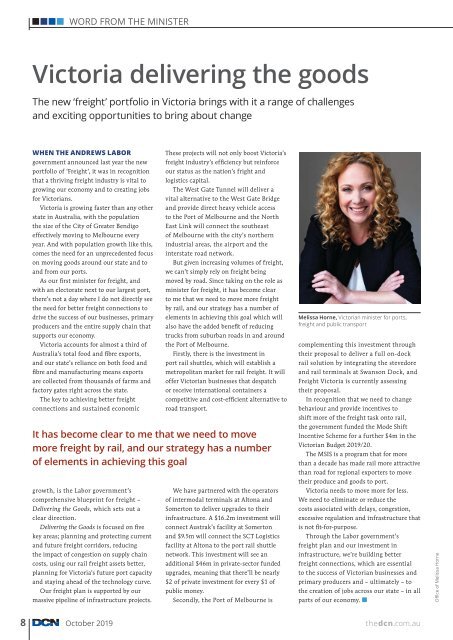DCN October Edition 2019
You also want an ePaper? Increase the reach of your titles
YUMPU automatically turns print PDFs into web optimized ePapers that Google loves.
WORD FROM THE MINISTER<br />
Victoria delivering the goods<br />
The new ‘freight’ portfolio in Victoria brings with it a range of challenges<br />
and exciting opportunities to bring about change<br />
WHEN THE ANDREWS LABOR<br />
government announced last year the new<br />
portfolio of ‘Freight’, it was in recognition<br />
that a thriving freight industry is vital to<br />
growing our economy and to creating jobs<br />
for Victorians.<br />
Victoria is growing faster than any other<br />
state in Australia, with the population<br />
the size of the City of Greater Bendigo<br />
effectively moving to Melbourne every<br />
year. And with population growth like this,<br />
comes the need for an unprecedented focus<br />
on moving goods around our state and to<br />
and from our ports.<br />
As our first minister for freight, and<br />
with an electorate next to our largest port,<br />
there’s not a day where I do not directly see<br />
the need for better freight connections to<br />
drive the success of our businesses, primary<br />
producers and the entire supply chain that<br />
supports our economy.<br />
Victoria accounts for almost a third of<br />
Australia’s total food and fibre exports,<br />
and our state’s reliance on both food and<br />
fibre and manufacturing means exports<br />
are collected from thousands of farms and<br />
factory gates right across the state.<br />
The key to achieving better freight<br />
connections and sustained economic<br />
growth, is the Labor government’s<br />
comprehensive blueprint for freight –<br />
Delivering the Goods, which sets out a<br />
clear direction.<br />
Delivering the Goods is focused on five<br />
key areas; planning and protecting current<br />
and future freight corridors, reducing<br />
the impact of congestion on supply chain<br />
costs, using our rail freight assets better,<br />
planning for Victoria’s future port capacity<br />
and staying ahead of the technology curve.<br />
Our freight plan is supported by our<br />
massive pipeline of infrastructure projects.<br />
These projects will not only boost Victoria’s<br />
freight industry’s efficiency but reinforce<br />
our status as the nation’s fright and<br />
logistics capital.<br />
The West Gate Tunnel will deliver a<br />
vital alternative to the West Gate Bridge<br />
and provide direct heavy vehicle access<br />
to the Port of Melbourne and the North<br />
East Link will connect the southeast<br />
of Melbourne with the city’s northern<br />
industrial areas, the airport and the<br />
interstate road network.<br />
But given increasing volumes of freight,<br />
we can’t simply rely on freight being<br />
moved by road. Since taking on the role as<br />
minister for freight, it has become clear<br />
to me that we need to move more freight<br />
by rail, and our strategy has a number of<br />
elements in achieving this goal which will<br />
also have the added benefit of reducing<br />
trucks from suburban roads in and around<br />
the Port of Melbourne.<br />
Firstly, there is the investment in<br />
port rail shuttles, which will establish a<br />
metropolitan market for rail freight. It will<br />
offer Victorian businesses that despatch<br />
or receive international containers a<br />
competitive and cost-efficient alternative to<br />
road transport.<br />
It has become clear to me that we need to move<br />
more freight by rail, and our strategy has a number<br />
of elements in achieving this goal<br />
We have partnered with the operators<br />
of intermodal terminals at Altona and<br />
Somerton to deliver upgrades to their<br />
infrastructure. A $16.2m investment will<br />
connect Austrak’s facility at Somerton<br />
and $9.5m will connect the SCT Logistics<br />
facility at Altona to the port rail shuttle<br />
network. This investment will see an<br />
additional $46m in private-sector funded<br />
upgrades, meaning that there’ll be nearly<br />
$2 of private investment for every $1 of<br />
public money.<br />
Secondly, the Port of Melbourne is<br />
Melissa Horne, Victorian minister for ports,<br />
freight and public transport<br />
complementing this investment through<br />
their proposal to deliver a full on-dock<br />
rail solution by integrating the stevedore<br />
and rail terminals at Swanson Dock, and<br />
Freight Victoria is currently assessing<br />
their proposal.<br />
In recognition that we need to change<br />
behaviour and provide incentives to<br />
shift more of the freight task onto rail,<br />
the government funded the Mode Shift<br />
Incentive Scheme for a further $4m in the<br />
Victorian Budget <strong>2019</strong>/20.<br />
The MSIS is a program that for more<br />
than a decade has made rail more attractive<br />
than road for regional exporters to move<br />
their produce and goods to port.<br />
Victoria needs to move more for less.<br />
We need to eliminate or reduce the<br />
costs associated with delays, congestion,<br />
excessive regulation and infrastructure that<br />
is not fit-for-purpose.<br />
Through the Labor government’s<br />
freight plan and our investment in<br />
infrastructure, we’re building better<br />
freight connections, which are essential<br />
to the success of Victorian businesses and<br />
primary producers and – ultimately – to<br />
the creation of jobs across our state – in all<br />
parts of our economy.<br />
Office of Melissa Horne<br />
8 <strong>October</strong> <strong>2019</strong><br />
thedcn.com.au
















